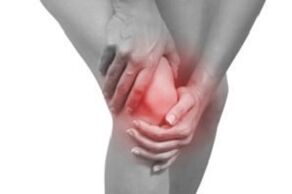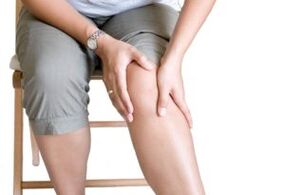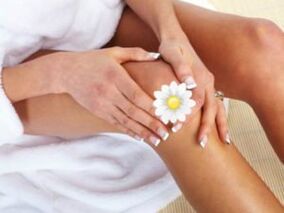
Of all the joints in the human body, knee pain is the most common complaint of people. The knee joint is complex, it bears a large load during various types of physical activity, therefore, there are many reasons for pain in it. Knee pain, even if it occurs occasionally and goes away on its own, should not be noticed.
Knee pain, regardless of its intensity, significantly affects quality of life. No excitement from your favorite type of outdoor activity, reduced efficiency, and an easy shopping trip is a problem.
In our article, we will consider what to do if the knee joint hurts, how to treat it and whether it is possible to get rid of the discomfort in the knee forever - the last question is particularly relevant for older people who consider sedentary movements and joint pain age companion syndrome veryrequired.
Diagnostics of pain
- It is necessary to know the nature of the pain. The pain can be sharp, burning, stabbing, aching.
- Eliminates the state of onset of pain - at night, after exercising, while walking, in the morning, a sudden sharp pain.
- Are there any other signs of joint damage: swelling, hyperemia (redness), joint deformity, throbbing, restriction of movement.
- Check history of infection, stress, foot injury or increased physical activity.
- Undergo instrumental examinations in medical and preventive institutions (LPU) - blood tests, X -ray diagnostics, analysis of synovial fluid.
Causes of knee pain
There are more than 200 articular pathologies, most of which are accompanied by more than just pain. Only based on the complex of symptoms and examination can you determine what is causing your knee pain.
Traumatic pathology
In traumatic pathology, knee pain occurs with joint injuries (blows, falls, prolonged pressure on the joints - typical for athletes) or with general diseases of the body.
Let us consider the main traumatic pathology.
Broken knee
Fracture or displacement of the patella, fracture of the femoral condylus and / or tibia. When you fall from a height on your knees, in the event of a car accident, etc.
The victim experiences severe sharp pain at the time of impact, over time the pain does not stop, it may become a little weaker, but gets stronger by pressing or walking.
The joints swell, become deformed, filled with blood (hemarthrosis), the knee is not bent, and the patella becomes abnormally moving.
Dislocated knee

It is characterized by displacement of the joint bones relative to each other. Knee joint dislocations have varying complexity (complete, incomplete, complicated by soft tissue rupture, etc. ).
Dislocations usually occur as a result of knee injury or as a result of congenital anomalies: weakness or excessive elasticity of the ligaments, flat sliding passages on the femur at the joint, excessive patellar position.
Knee joint dislocation is a fairly serious injury, and if you don’t treat it in a timely manner, it can all end in serious complications. Knee joint dislocation is the most painful of all types, although it is a rare occurrence.
Serious injuries such as dislocations should be treated in a medical institution, so there should be no independent intervention. This is what traumatologists do.
Sprains, ruptured tendons, ligaments
Depending on the degree of damage (partial rupture of individual fibers, incomplete tear, complete rupture), symptoms occur: throbbing and clicking during movement, bruising below the site of rupture, limit expansion-flexion of the joint, swelling of the knee, overly mobile joints. (with complete fracture of the ligament). The pain is sharp and severe, but with a small injury it may not appear immediately, but after some time.
Bursitis
Inflammation of the periarticular bursa due to trauma, infection, metabolic disorders, autoimmune diseases. Often occurs in athletes and people who are experiencing weight gain. The knee is swollen, the pain varies in intensity, but increases with energy and at night.
Tear the meniscus
Probably due to trauma or degenerative changes in cartilage tissue. Acute trauma is characterized by severe pain, swelling, and limited mobility. The symptoms for degenerative changes are mild.
Joint disease
Knee pain can be a symptom of a medical condition.
We have listedThe most common diseases with knee pain syndrome:
joint pain
Diagnosis is less common than in the 19th and 20th centuries. This is due both to the discovery of penicillin (and later to the production of other antibiotics), and the low diagnostic ability in the past, when almost all joint diseases were associated with rheumatism.
The hallmark of rheumatism is alternating joint pain: first, one joint becomes inflamed, then the other. For example, knee pain is reduced, but occurs in other large joints (elbows, hips).
Rheumatism is more common in children and adolescents, the disease develops after a streptococcal infection of the upper respiratory tract.
Note: advanced rheumatism leads to damage to the heart (rheumatic heart disease) or nervous system (chorea).
Reactive arthritis
It is more common in people of reproductive age, as inflammation of the joints is most often caused by pathogenic microbes that enter the human body sexually.
More rarely, reactive arthritis is caused by an infection of the gastrointestinal tract or infectious inflammation of the nasopharynx (sore throat, flu). After 1-4 weeks after the disease, the patient noticed that his legs began to ache at night.
Both large joints (knees, ankles) and small ones (sore or sore big toes) can become inflamed and painful. Knee pain is accompanied by swelling and / or redness.
Occasionally symptoms include conjunctivitis (inflammation and pain in the eyes), keratoderma (thickening of the skin on the soles of the feet).
Reiter's syndrome
Urethritis (frequent painful urination) and bowel disorders accompany the symptoms of common reactive arthritis.
Osteoarthritis
Diseases of the elderly. Periodically the knee hurts at night "for the weather. " Loads on the joints (long walks) increase pain, swelling, and affect joint movement.
After resting and warming up, the pain disappeared.
Cyst Baker
Swelling in the back of the knee, causing a feeling of constriction, difficulty in movement.
Osteochondritis dissecans (Köning's disease)
The cartilage that covers the bone is exfoliated, the knee is sore, and when the fragment is completely exfoliated, the movement of the joint is impeded.
Osgood-Schlatter disease
It is more often diagnosed in adolescents. Knee pain increases when going up and down stairs, squatting.
Rheumatoid arthritis
Autoimmune diseases, the mechanism of which is unclear. It is noted that the initial condition is a common list of loads on the immune system: from stress and infection, to hypothermia. Immune bodies that attack their own cells cause inflammation of the joints, especially the synovium.
Under the influence of attack by immune cells, the membrane swells, increases in volume, and then begins to grow into cartilage and nearby bone tissue. The result of the process was pain in the knee joint, which became unbearable in the second half of the night.
The disease lasts for many years, treatment consists of non-steroidal anti-inflammatory drugs, corticosteroid hormones, gold preparations, immunosuppressants, antimalarial drugs.
Arises from improper metabolism. Due to alcohol abuse, "purine" products (meat, smoked meats, pickles).
Uric acid produced in the blood is stored in the joints in the form of uric sodium crystals. The increasing "deposits" gradually affect the mobility of the joints, severe pain attacks appear, the time interval between attacks is gradually reduced.
Vascular pain in the knee is characterized by an interesting sensation along the vein, sometimes the patient sees an acute tingling sensation.
Only a doctor, after a detailed examination, can tell why the knee hurts, if there is no obvious injury. It is unwise to rub the knee joint with a drug that "helps the neighbor". After all, what helps to heal a joint injury can trigger a severity in the autoimmune mechanisms of the disease.
Treatment of knee pain
Doctors choose a treatment regimen depending on the diagnosis.
Therapeutic measures aimed at combating:
- with the cause of the disease - infections, tumors, abnormal metabolic processes, failure of the immune system.
- with pain syndrome - symptomatic treatment includes pain relievers, intra -articular blockade.
- with degenerative processes - drugs with chondroprotectors help restore cartilage tissue of the joints.
If necessary, use surgery, endoprosthetics, use physiotherapy and therapeutic exercises for the joints.
Pain Relief Products
A checklist for those with knee pain - what to do to relieve the condition.
| The cause of the pain | What to do |
|---|---|
| The pain clearly stems from trauma | Provide joint and limb immobility, ice or cold compresses on the knees. Immediate medical attention. |
| Pain in arthritis (reactive, rheumatoid, etc. ) | Specific treatment with antimicrobial and anti-inflammatory drugs is prescribed only by a doctor. For night pain, you can use warming compresses, ointments based on bee venom. |
| Pain in arthrosis (after trauma, age -related, overweight) after exercise or at night | Any warming compresses with herbal tincture, rub in ointment with chondroprotectors. |
Severe joint pain is relieved with nonsteroidal anti-inflammatory drugs (NSAIDs).
But most patients (people who are overweight, age -related changes in the joints) do not have to think about what to do with the pain if they adhere to a minimum of prevention:
- Proper nutrition with adequate amounts of calcium, vitamins, combating excess weight;
- Severe pressure reduction on the joints until a change of work, if it consists of "standing on your feet" all day;
- Systematic physical therapy to strengthen muscles and ligaments - a good muscle corset reduces the load on the bones;
Joint disease can develop over years and lead to a significant deterioration in quality of life. Timely visits to the doctor and a arsenal of folk remedies will help maintain the joy of movement until old age.
Joint treatment at home - folk recipes
Homemade recipes for ointments and compresses based on natural ingredients are used in the course - this is the only way to achieve lasting results.
7 simple folk remedies for knee pain:
- Cabbage leaves. On fresh leaves, cuts are made so that the juice comes out. Place a spoonful of honey in the middle and apply this "compress" to the knees. The sheet is fixed with a bandage. Wear a bandage all day or perform the procedure at night. Burdock and plantain leaves are used in the same way.
- Colored propolis for arthritis. If the knee "twists" at night (the cause of dull pain can be due to weather changes to the pressure on the foot), lubricate the joint with a mixture, rub it into the skin until it dries. If the knee is very sore, then they make a full compress: moisten the soft tissue with tincture and apply on the joints, cover them with a film, and wrap with a scarf. This tool is also used to warm the joints if the sore knee has been cold. Similarly, they use tinctures of natural stimulants: aloe, Kalanchoe, mummy, dead bees.
Important:biologically active substances should not be used if the disease is autoimmune in nature. Stimulants activate the immune system and exacerbate the disease.
- Compressed gelatin. A piece of gauze soaked in hot water is squeezed, 1 tsp is poured into the middle. gelatin, applied to the joints, wrapped in food foil and wrapped. Repeat the procedure for 14 days at night. This product promotes joint nutrition and cartilage regeneration.
- A mustard compress will help if your knee hurts badly. Take honey and dried mustard in equal proportions, add warm water and salt until a gruel consistency is formed. Lubricate the knees with the mixture, lying on a cloth with a film and bandage. Exposure time 20–40 min. , Remove in case of severe burning sensation. Compressed mustard is used for daily pain.
- So that the feet do not hurt, the drug is prepared for oral administration: gelatin is stirred in 0. 5 liters of water in the evening, heated in the morning until it is completely dissolved. The mixture is taken before meals for ¼ - 1/2 cup, they drink for a month.
- Internal goat fat (100 g) mixed with balm "Zvezdochka" (1 jar), the resulting ointment is applied to the pain of veins and joints in the knee.
- Kefir mask. 0. 5 l of kefir crumbs, add 1 tsp. Soda. The mixture was insisted for 6 hours. Then the liquid is filtered, moistened with gauze and compresses are made overnight for several days, until the pain disappears.

It is advisable to apply treatment at home with folk remedies regularly, combining with traditional medicine and modern methods. Do not wait until the disease is well established and declares itself with severe pain, joint deformities. An early visit to the doctor will speed recovery, while chronic forms of the disease are more difficult to cure.
Note:treatment with folk remedies is allowed only with the approval of a doctor, after examination and diagnosis.

















































